Monday, October 8th, 2012 at 11:08 pm
When I was in Okinawa visiting my sister, she took me to her favorite place for snorkeling.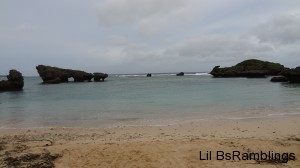 She said that she often goes to that spot or one nearby to unwind after a long day at work but doesn’t often go snorkeling there. High tide in Okinawa is early morning (that day it was at 5 am) or near when the sun goes down and visibility goes way down.
She said that she often goes to that spot or one nearby to unwind after a long day at work but doesn’t often go snorkeling there. High tide in Okinawa is early morning (that day it was at 5 am) or near when the sun goes down and visibility goes way down.
I had never gone snorkeling before so I had trouble putting on all my gear, especially the mouth piece.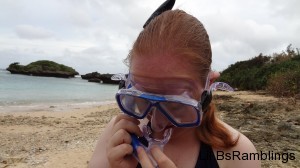 Snorkeling was fun, except that I forgot one thing. I hate having my face in the water. It took me a number of tries to force myself to relax, even enough to float on top of the water and look down. My sister mentioned afterwards that the last time she had come, her friend had brought a lubricant she put on the goggles. Yeah, my sister didn’t realize how important that lubricant was until our goggles fogged up almost immediately. It didn’t help my fear of being underwater that things were blurry since I couldn’t wear my glasses with the goggles and I could only see clearly near the edges of the mask. However, I did see some little fishies that traveled close enough to be seen. I didn’t leave the cove that we were in for deeper water (I needed to be where I could stand up every time I got water in my mouthpiece or too much water in my goggles) where the better coral is so I didn’t see much besides small coral formations, rocks, and adventurous fish that seemed partially transparent underwater. Still it was rather nice to float at the top of the water and look down. I can see why people would get up early to snorkel or spend hundreds on trips to the best snorkeling spots in the world. I doubt I’ll ever do it again since my terror wil probably ruin the effect for my companions, but it was a fun experience.
Snorkeling was fun, except that I forgot one thing. I hate having my face in the water. It took me a number of tries to force myself to relax, even enough to float on top of the water and look down. My sister mentioned afterwards that the last time she had come, her friend had brought a lubricant she put on the goggles. Yeah, my sister didn’t realize how important that lubricant was until our goggles fogged up almost immediately. It didn’t help my fear of being underwater that things were blurry since I couldn’t wear my glasses with the goggles and I could only see clearly near the edges of the mask. However, I did see some little fishies that traveled close enough to be seen. I didn’t leave the cove that we were in for deeper water (I needed to be where I could stand up every time I got water in my mouthpiece or too much water in my goggles) where the better coral is so I didn’t see much besides small coral formations, rocks, and adventurous fish that seemed partially transparent underwater. Still it was rather nice to float at the top of the water and look down. I can see why people would get up early to snorkel or spend hundreds on trips to the best snorkeling spots in the world. I doubt I’ll ever do it again since my terror wil probably ruin the effect for my companions, but it was a fun experience. After snorkeling we returned our gear to my sister’s car and went to the public restroom nearby. It was still early so we decided to explore the area and found a hiking path that led down to a picnic area and a lovely spot for pictures of lava rock that had eroded into various shapes with moss growing on it and water in the background.
After snorkeling we returned our gear to my sister’s car and went to the public restroom nearby. It was still early so we decided to explore the area and found a hiking path that led down to a picnic area and a lovely spot for pictures of lava rock that had eroded into various shapes with moss growing on it and water in the background.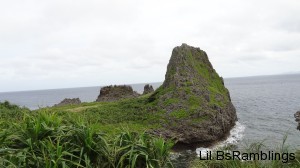
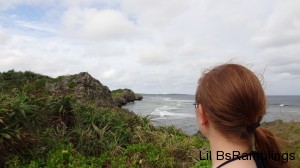
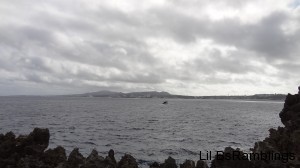 All in all it was a lovely day although that night the typhoon hit that took out our power for a day, an odd thing on Okinawa where typhoons are so common. Due to the storm the rest of my trip was limited but it was fun to see my sister again and explore the beautiful island of Okinawa.
All in all it was a lovely day although that night the typhoon hit that took out our power for a day, an odd thing on Okinawa where typhoons are so common. Due to the storm the rest of my trip was limited but it was fun to see my sister again and explore the beautiful island of Okinawa.
Saturday, October 6th, 2012 at 3:08 am
On Thursday night my sister and I went to a dinner theater in Okinawa. We got to eat little bits of really good food (small portions of a lot of dishes equal a full multi-course meal) while the performers did traditional dance to entertain us. My sister and I know very little Japanese so we couldn’t understand the singing and never did figure out what the story they performed was. However, as my sister reminded me we had learned at the kabuki play last year, the Japanese theater pays less attention to the story and more attention to the image. The imagery of the dancers in Japanese traditional outfit dancing around the stage in time with the strong or soft spots in the music, singing along occasionally, was definitely striking.
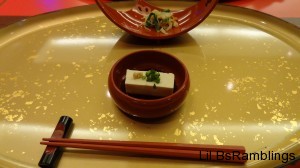 The night started out with us being late so this is what awaited us when we showed up. Most of the other patrons were already on their second helping but there were also two other sets of people that came in after us, so we didn’t feel too bad. My sister said that Okinawans are not known for being early, or even on time all the time. The dinner theater seemed to have taken that into consideration because the meal started at 6:30 while the performance started at 7:00 pm. The meal was rather good with sushi, a few different types of salads, a very good chunk of meat (in the covered bowl), and tempura fish.
The night started out with us being late so this is what awaited us when we showed up. Most of the other patrons were already on their second helping but there were also two other sets of people that came in after us, so we didn’t feel too bad. My sister said that Okinawans are not known for being early, or even on time all the time. The dinner theater seemed to have taken that into consideration because the meal started at 6:30 while the performance started at 7:00 pm. The meal was rather good with sushi, a few different types of salads, a very good chunk of meat (in the covered bowl), and tempura fish.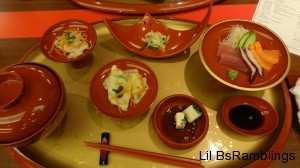 My sister didn’t much like the idea of eating a full fish, scales, head, fin and all. Since I ate mine (stopping at the fin) she gave me hers to eat and thought it was hilarious that I actually ate the fish.
My sister didn’t much like the idea of eating a full fish, scales, head, fin and all. Since I ate mine (stopping at the fin) she gave me hers to eat and thought it was hilarious that I actually ate the fish. Hers was a little more salty than mine had been but otherwise it was fine, as long as I didn’t see the face as I ate it. Somethings are just better to not think about while. or after, you do them.
Hers was a little more salty than mine had been but otherwise it was fine, as long as I didn’t see the face as I ate it. Somethings are just better to not think about while. or after, you do them.
Not long after the fish incident, the lights dimmed and the stage lights started to dance around the stage in alternating colors. Then two ladies came out and knelt with their backs to us. As they started to dance on the darkened stage, they clicked together two wooden blocks in each hand, adding a nearly cymbal-like sound to the music playing through the hidden speakers.
As they started to dance on the darkened stage, they clicked together two wooden blocks in each hand, adding a nearly cymbal-like sound to the music playing through the hidden speakers. 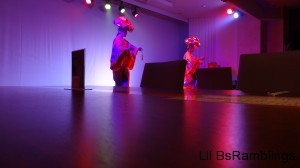 After they walked off stage two male eisu dancers walked on and started their dance.
After they walked off stage two male eisu dancers walked on and started their dance. 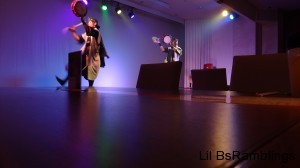 Eisa dancers are people, often men, who dance with drums, hitting them in tone with the music in a traditional Okinawan dance. One of the dancers broke his drumstick in half. The broken half he kicked to the back wall and the half he held, with the tassel, he used to hit the drum. It probably wasn’t as loud or perfect to hit the drum with the tassel end but it still worked for the show.
Eisa dancers are people, often men, who dance with drums, hitting them in tone with the music in a traditional Okinawan dance. One of the dancers broke his drumstick in half. The broken half he kicked to the back wall and the half he held, with the tassel, he used to hit the drum. It probably wasn’t as loud or perfect to hit the drum with the tassel end but it still worked for the show.
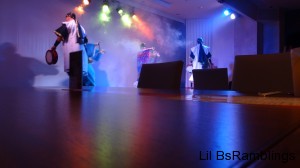 Soon the two lady dancers came out again, this time in peasant outfits and the eisa dancers went backstage. The ladies danced with flower branches
Soon the two lady dancers came out again, this time in peasant outfits and the eisa dancers went backstage. The ladies danced with flower branches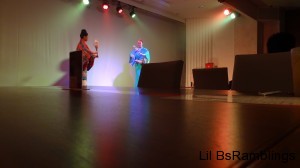 and finished with scrolls that said something in Japanese.
and finished with scrolls that said something in Japanese. 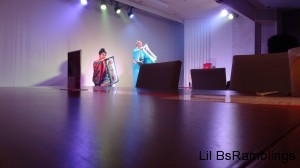 They left and the shisa dog came out to prance about the stage.
They left and the shisa dog came out to prance about the stage. It was rather impressive when you think of how perfectly in time they were to have the person at the head of the body snapping the wooden jaws shut with the dance and the two people able to coordinate enough to roll around on the ground like a real dog would. Shisa dogs are popular in Okinawa due to the belief that the mix of dog and lion creatures are protective wards that protect houses.
It was rather impressive when you think of how perfectly in time they were to have the person at the head of the body snapping the wooden jaws shut with the dance and the two people able to coordinate enough to roll around on the ground like a real dog would. Shisa dogs are popular in Okinawa due to the belief that the mix of dog and lion creatures are protective wards that protect houses. 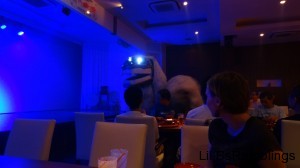 After a little while the shisa dog turned on glowing eyes and walked down the steps to walk among the tables. Yes, it did try to eat my sister.
After a little while the shisa dog turned on glowing eyes and walked down the steps to walk among the tables. Yes, it did try to eat my sister.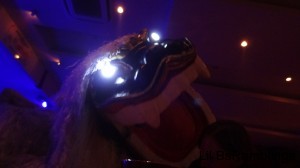 Next the ladies came out for a brief dance before the older one left the younger one to dance alone.
Next the ladies came out for a brief dance before the older one left the younger one to dance alone. 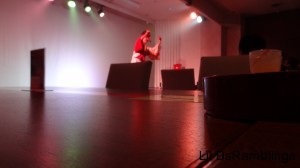 After a short dance with the clappers, the other lady came out to dance alone as a warrior.
After a short dance with the clappers, the other lady came out to dance alone as a warrior. 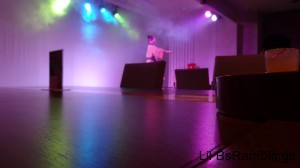 Soon the other girl came out in warrior outfit and they danced a short dance together. Soon they were replaced by the two male eisa dancers and a female eisa dancer.
Soon the other girl came out in warrior outfit and they danced a short dance together. Soon they were replaced by the two male eisa dancers and a female eisa dancer. 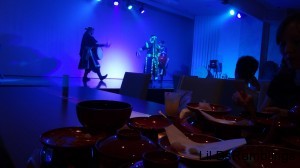 This time the men had the big drums and the girl had the small drum. They danced around the stage in their high stepping drum dance
This time the men had the big drums and the girl had the small drum. They danced around the stage in their high stepping drum dance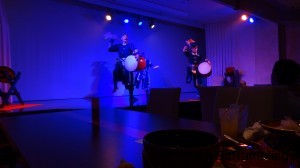 until the two men left the lady warrior to dance alone. Then the two ladies came back on to dance with her.
until the two men left the lady warrior to dance alone. Then the two ladies came back on to dance with her. 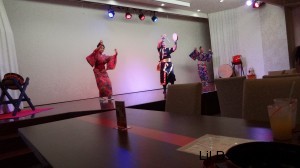 The two lady dancers then went into the crowd and brought people on stage. My sister went up while I stayed put to take pictures.
The two lady dancers then went into the crowd and brought people on stage. My sister went up while I stayed put to take pictures.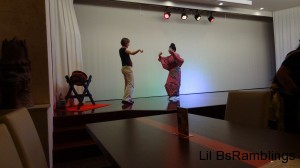 Soon others joined my sister on stage and they all danced.
Soon others joined my sister on stage and they all danced. 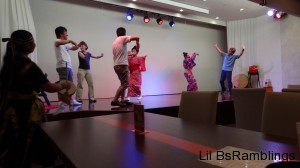 Then the shisa dog joined them
Then the shisa dog joined them 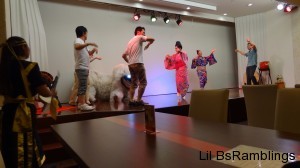 for a minute before going out among the tables again to see what trouble it could cause.
for a minute before going out among the tables again to see what trouble it could cause. 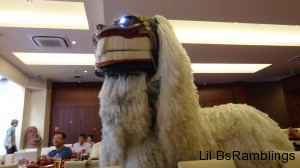 The dog went back on stage and the show was over. The cast bowed (yes, the male eisa dancers were the two parts of the dog)
The dog went back on stage and the show was over. The cast bowed (yes, the male eisa dancers were the two parts of the dog)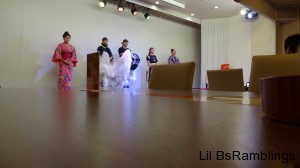 and we got to take pictures with the cast.
and we got to take pictures with the cast.  After picture time, the “dog” stood up, shook itself off,
After picture time, the “dog” stood up, shook itself off,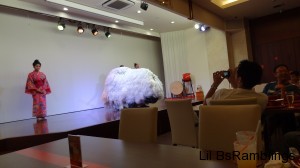 and trotted off stage.
and trotted off stage. Show complete.
Show complete.
The night was not complete for us though. On the walk back to the car we found these cuties.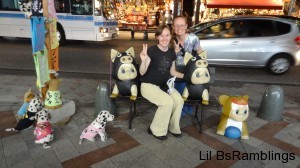 The baby “animals” are permanently attached to the bench while the dogs are stuffed animals advertising the doggie shirts sold at the store behind the camera. If you look closely you can see the babies are bigger versions of the old dolls that were popular in the US years ago (as in they were going out of popularity when I was a kid) but they have maintained their popularity in Japan and are a popular souvenir item in various outfits and a popular craft seems to be to create outfits for these small baby dolls.
The baby “animals” are permanently attached to the bench while the dogs are stuffed animals advertising the doggie shirts sold at the store behind the camera. If you look closely you can see the babies are bigger versions of the old dolls that were popular in the US years ago (as in they were going out of popularity when I was a kid) but they have maintained their popularity in Japan and are a popular souvenir item in various outfits and a popular craft seems to be to create outfits for these small baby dolls.
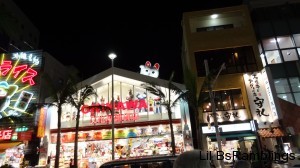 We also passed a store that sold souvenirs and was decorated by super heroes and other popular icons. You can see Hello Kitty coming out of the roof, various superheros in the window below, and you can’t see Tweety Bird comfortable in a shark’s mouth ( or was it a whale?) in the store along with many other favorites. I’m not sure what the life size dolls had to do with the merchandise since the store seemed like it was merely a normal Okinawan souvenier store, but it was eye catching. It was later at night than I like to be out so we didn’t stop to investigate the store. We took a picture and got in her car, soon we were home and getting ready for bed. hmm, bed… A late day should mean a late morning but no such luck. High tide was 5 am and we were going snorkeling the next day so no sleeping in for us. (Okay, just a little)
We also passed a store that sold souvenirs and was decorated by super heroes and other popular icons. You can see Hello Kitty coming out of the roof, various superheros in the window below, and you can’t see Tweety Bird comfortable in a shark’s mouth ( or was it a whale?) in the store along with many other favorites. I’m not sure what the life size dolls had to do with the merchandise since the store seemed like it was merely a normal Okinawan souvenier store, but it was eye catching. It was later at night than I like to be out so we didn’t stop to investigate the store. We took a picture and got in her car, soon we were home and getting ready for bed. hmm, bed… A late day should mean a late morning but no such luck. High tide was 5 am and we were going snorkeling the next day so no sleeping in for us. (Okay, just a little)
Wednesday, September 26th, 2012 at 9:27 pm
I’m no history buff when it comes to World War 2 so I was relatively surprised to learn that Okinawa was the site of a huge battle, the Battle of Okinawa. When my sister suggested that we visit the tunnels of the former Japanese Navy Underground Headquarters, I jumped at the chance. To show you where we are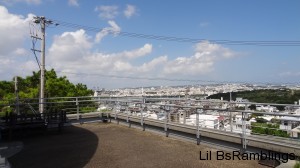 this is the view from the visitor’s entrance on top of the tunnels
this is the view from the visitor’s entrance on top of the tunnels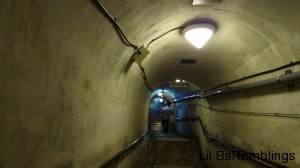 and this is the stairs we went down to get to the headquarters.
and this is the stairs we went down to get to the headquarters.
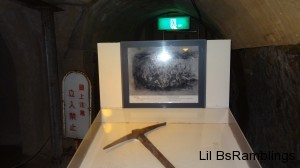 The 450 meter tunnels were cut by hand with pickaxes by hand to hold the 4000 men they would hide. Earlier in the battle the sailors had built and fortified these tunnels as the headquarters of their navy.
The 450 meter tunnels were cut by hand with pickaxes by hand to hold the 4000 men they would hide. Earlier in the battle the sailors had built and fortified these tunnels as the headquarters of their navy.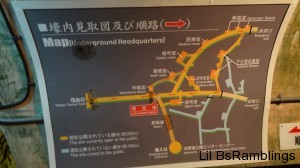 When they were ordered north to another position, they had destroyed the weapons that were hard to carry, like cannons and other big guns. When they arrived to their new headquarters, they found barely any protection and begged their leader
When they were ordered north to another position, they had destroyed the weapons that were hard to carry, like cannons and other big guns. When they arrived to their new headquarters, they found barely any protection and begged their leader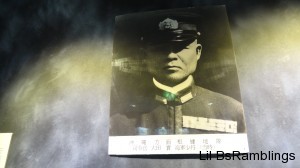 Rear Admiral Minoru Ota to return to the tunnels for a final stand against the Americans. Finally he agreed and the Navy sailors that could still move went back to the underground headquarters.
Rear Admiral Minoru Ota to return to the tunnels for a final stand against the Americans. Finally he agreed and the Navy sailors that could still move went back to the underground headquarters.
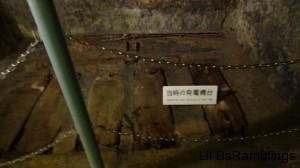 The tunnels were powered by 3 generators kept in spaces like this one.
The tunnels were powered by 3 generators kept in spaces like this one.
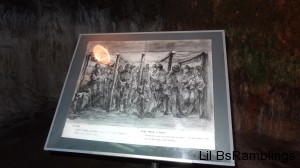
Space was so tight the petty officers, at least a few hundred men, had to sleep standing up, leaning against poles.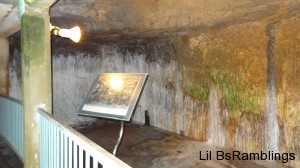 The petty officers had two rooms this size
The petty officers had two rooms this size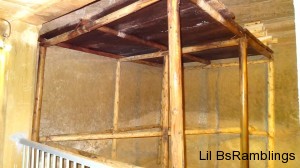 and this is a recreation of what they had to sleep on. Their motto by this time in the war was “Do Without Until We Win” and this headquarters is a good example of that ideal. Even the Rear Admiral went with that ideal.
and this is a recreation of what they had to sleep on. Their motto by this time in the war was “Do Without Until We Win” and this headquarters is a good example of that ideal. Even the Rear Admiral went with that ideal.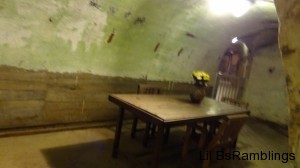 This is his office/dinningroom/sleeping quarters. Although he was the only person in the complex to have his own room, he got much less than most officers would demand now a days. There medical area was merely a cave in the wall where supplies were kept and there might be enough room for a new patient to be laid on the floor to be treated.
This is his office/dinningroom/sleeping quarters. Although he was the only person in the complex to have his own room, he got much less than most officers would demand now a days. There medical area was merely a cave in the wall where supplies were kept and there might be enough room for a new patient to be laid on the floor to be treated.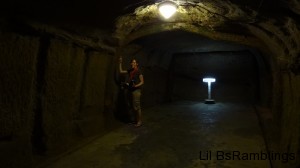 The code room was the biggest room in the complex and where the Japanese codebreakers would work for hours trying to break the American code or communicating with their own forces.
The code room was the biggest room in the complex and where the Japanese codebreakers would work for hours trying to break the American code or communicating with their own forces.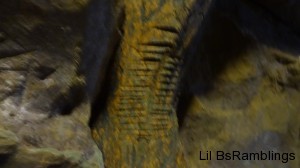 My sister is pointing at these in the ceiling beam. She thought they might be some sort of code, I thought they may have been counting the days they were in the tunnels, similar to a calender. Then we realized that the room had been redone and the supports were merely a form of plastic made to look like wood. The marks are probably a recreation of how they bent the wood or something to do with building.
My sister is pointing at these in the ceiling beam. She thought they might be some sort of code, I thought they may have been counting the days they were in the tunnels, similar to a calender. Then we realized that the room had been redone and the supports were merely a form of plastic made to look like wood. The marks are probably a recreation of how they bent the wood or something to do with building.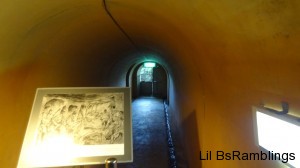 This is one of the main exits where the sailors ran out poorly armed to fight the incoming Americans. The Battle of Okinawa is known for its kamikaze attacks. Although used throughout the Pacific war, kamikaze attacks were a huge part of the Japanese defense strategy. With few planes and barely any weapons remaining, kamikazes,both on plane, on land and when possible by water on small speed boats were used. It was common for sailors to be sent from the tunnels with a few grenades, a sword attached to a stick as muskets were scarce, and orders of where to attack. A lot of Americans died due to these attacks but so did a lot of Japanese. They also used the local populations who mostly willingly fought for the Japanese. (The Wikipedia article says they were sent out at gunpoint to attack the Americans but the Rear Admiral sent a message back to Tokyo saying how willingly the civilians helped the war effort, even as they lost their homes and lives. He was requesting that the government look kindly on the Okinawans in the future.)
This is one of the main exits where the sailors ran out poorly armed to fight the incoming Americans. The Battle of Okinawa is known for its kamikaze attacks. Although used throughout the Pacific war, kamikaze attacks were a huge part of the Japanese defense strategy. With few planes and barely any weapons remaining, kamikazes,both on plane, on land and when possible by water on small speed boats were used. It was common for sailors to be sent from the tunnels with a few grenades, a sword attached to a stick as muskets were scarce, and orders of where to attack. A lot of Americans died due to these attacks but so did a lot of Japanese. They also used the local populations who mostly willingly fought for the Japanese. (The Wikipedia article says they were sent out at gunpoint to attack the Americans but the Rear Admiral sent a message back to Tokyo saying how willingly the civilians helped the war effort, even as they lost their homes and lives. He was requesting that the government look kindly on the Okinawans in the future.)
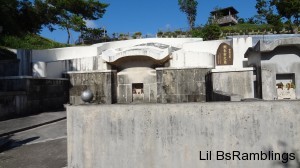 This s one of the few tombs on the site for all those who died in the tunnels. In the middle of June the highest ranking Japanese sailors, including Rear Admiral Ota, shot themselves in an honorable suicide inside the tunnels. When the tunnel was finally excavated years after the war, they found 2,400 people dead inside of the 5,000 men the rear admiral had brought back from the other position.
This s one of the few tombs on the site for all those who died in the tunnels. In the middle of June the highest ranking Japanese sailors, including Rear Admiral Ota, shot themselves in an honorable suicide inside the tunnels. When the tunnel was finally excavated years after the war, they found 2,400 people dead inside of the 5,000 men the rear admiral had brought back from the other position.
 She said that she often goes to that spot or one nearby to unwind after a long day at work but doesn’t often go snorkeling there. High tide in Okinawa is early morning (that day it was at 5 am) or near when the sun goes down and visibility goes way down.
She said that she often goes to that spot or one nearby to unwind after a long day at work but doesn’t often go snorkeling there. High tide in Okinawa is early morning (that day it was at 5 am) or near when the sun goes down and visibility goes way down. Snorkeling was fun, except that I forgot one thing. I hate having my face in the water. It took me a number of tries to force myself to relax, even enough to float on top of the water and look down. My sister mentioned afterwards that the last time she had come, her friend had brought a lubricant she put on the goggles. Yeah, my sister didn’t realize how important that lubricant was until our goggles fogged up almost immediately. It didn’t help my fear of being underwater that things were blurry since I couldn’t wear my glasses with the goggles and I could only see clearly near the edges of the mask. However, I did see some little fishies that traveled close enough to be seen. I didn’t leave the cove that we were in for deeper water (I needed to be where I could stand up every time I got water in my mouthpiece or too much water in my goggles) where the better coral is so I didn’t see much besides small coral formations, rocks, and adventurous fish that seemed partially transparent underwater. Still it was rather nice to float at the top of the water and look down. I can see why people would get up early to snorkel or spend hundreds on trips to the best snorkeling spots in the world. I doubt I’ll ever do it again since my terror wil probably ruin the effect for my companions, but it was a fun experience.
Snorkeling was fun, except that I forgot one thing. I hate having my face in the water. It took me a number of tries to force myself to relax, even enough to float on top of the water and look down. My sister mentioned afterwards that the last time she had come, her friend had brought a lubricant she put on the goggles. Yeah, my sister didn’t realize how important that lubricant was until our goggles fogged up almost immediately. It didn’t help my fear of being underwater that things were blurry since I couldn’t wear my glasses with the goggles and I could only see clearly near the edges of the mask. However, I did see some little fishies that traveled close enough to be seen. I didn’t leave the cove that we were in for deeper water (I needed to be where I could stand up every time I got water in my mouthpiece or too much water in my goggles) where the better coral is so I didn’t see much besides small coral formations, rocks, and adventurous fish that seemed partially transparent underwater. Still it was rather nice to float at the top of the water and look down. I can see why people would get up early to snorkel or spend hundreds on trips to the best snorkeling spots in the world. I doubt I’ll ever do it again since my terror wil probably ruin the effect for my companions, but it was a fun experience. After snorkeling we returned our gear to my sister’s car and went to the public restroom nearby. It was still early so we decided to explore the area and found a hiking path that led down to a picnic area and a lovely spot for pictures of lava rock that had eroded into various shapes with moss growing on it and water in the background.
After snorkeling we returned our gear to my sister’s car and went to the public restroom nearby. It was still early so we decided to explore the area and found a hiking path that led down to a picnic area and a lovely spot for pictures of lava rock that had eroded into various shapes with moss growing on it and water in the background.

 All in all it was a lovely day although that night the typhoon hit that took out our power for a day, an odd thing on Okinawa where typhoons are so common. Due to the storm the rest of my trip was limited but it was fun to see my sister again and explore the beautiful island of Okinawa.
All in all it was a lovely day although that night the typhoon hit that took out our power for a day, an odd thing on Okinawa where typhoons are so common. Due to the storm the rest of my trip was limited but it was fun to see my sister again and explore the beautiful island of Okinawa.












































